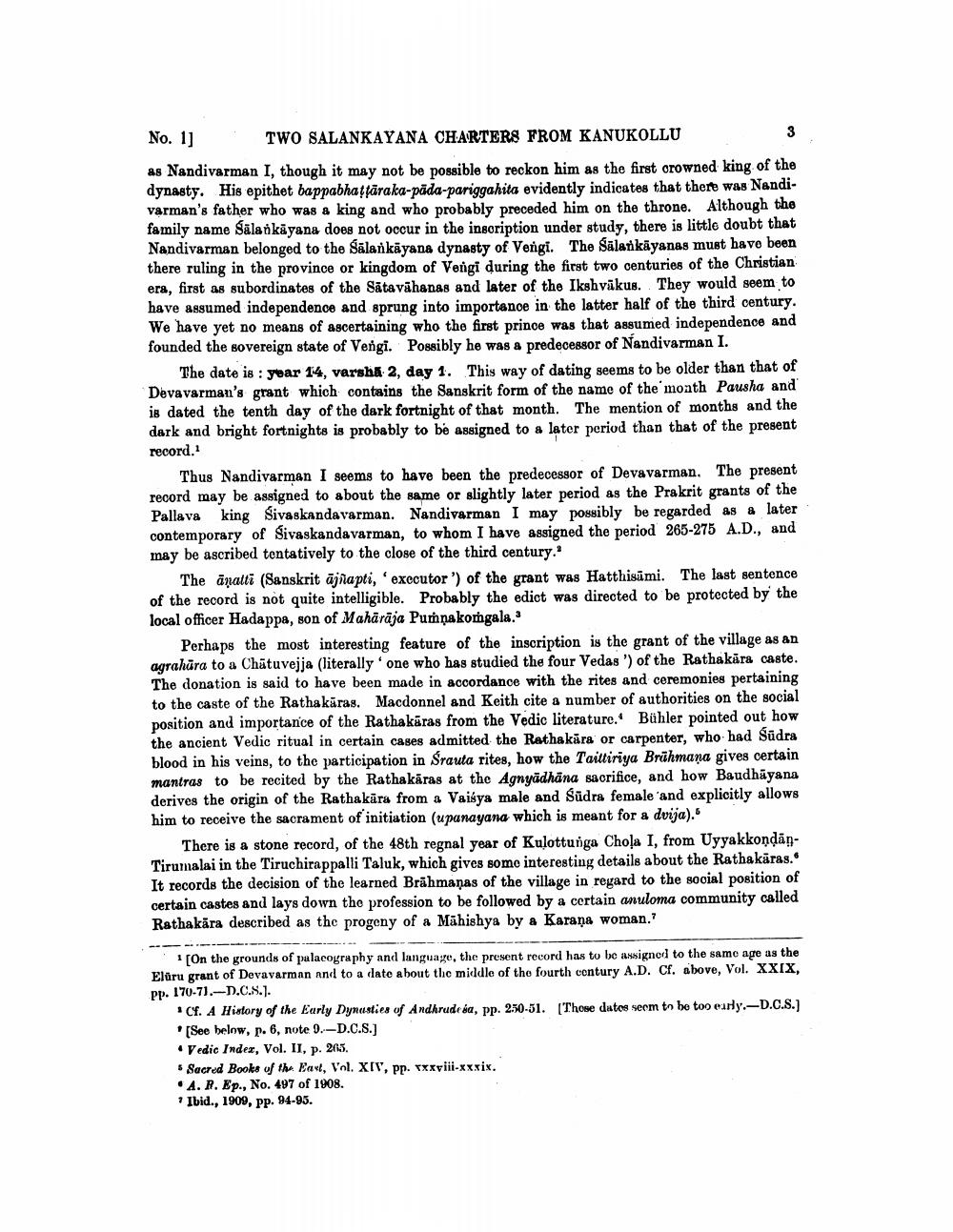________________
3
No. 1]
TWO SALANKAYANA CHARTERS FROM KANUKOLLU
as Nandivarman I, though it may not be possible to reckon him as the first crowned king of the dynasty. His epithet bappabhattaraka-pada-pariggahita evidently indicates that there was Nandivarman's father who was a king and who probably preceded him on the throne. Although the family name Salankayana does not occur in the inscription under study, there is little doubt that Nandivarman belonged to the Salankayana dynasty of Vengi. The Salankayanas must have been there ruling in the province or kingdom of Vengi during the first two centuries of the Christian era, first as subordinates of the Satavahanas and later of the Ikshvakus. They would seem to have assumed independence and sprung into importance in the latter half of the third century. We have yet no means of ascertaining who the first prince was that assumed independence and founded the sovereign state of Vengi. Possibly he was a predecessor of Nandivarman I.
The date is: year 14, varsha 2, day 1. This way of dating seems to be older than that of Devavarman's grant which contains the Sanskrit form of the name of the month Pausha and is dated the tenth day of the dark fortnight of that month. The mention of months and the dark and bright fortnights is probably to be assigned to a later period than that of the present record.1
Thus Nandivarman I seems to have been the predecessor of Devavarman. The present record may be assigned to about the same or slightly later period as the Prakrit grants of the Pallava king Sivaskandavarman. Nandivarman I may possibly be regarded as a later contemporary of Sivaskandavarman, to whom I have assigned the period 265-275 A.D., and may be ascribed tentatively to the close of the third century.
The anatti (Sanskrit ajnapti, 'executor') of the grant was Hatthisāmi. The last sentence of the record is not quite intelligible. Probably the edict was directed to be protected by the local officer Hadappa, son of Mahdrija Puthpakotgala,
Perhaps the most interesting feature of the inscription is the grant of the village as an agrahāra to a Chātuvejja (literally one who has studied the four Vedas') of the Rathakara caste. The donation is said to have been made in accordance with the rites and ceremonies pertaining to the caste of the Rathakaras. Macdonnel and Keith cite a number of authorities on the social position and importance of the Rathakaras from the Vedic literature. Bühler pointed out how the ancient Vedic ritual in certain cases admitted the Rathakara or carpenter, who had Sudra blood in his veins, to the participation in Srauta rites, how the Taittiriya Brahmana gives certain mantras to be recited by the Rathakaras at the Agnyädhäna sacrifice, and how Baudhayana derives the origin of the Rathakara from a Vaisya male and Südra female and explicitly allows him to receive the sacrament of initiation (upanayana which is meant for a dvija).
There is a stone record, of the 48th regnal year of Kulottunga Chola I, from UyyakkonḍāṇTirumalai in the Tiruchirappalli Taluk, which gives some interesting details about the Rathakaras. It records the decision of the learned Brahmaņas of the village in regard to the social position of certain castes and lays down the profession to be followed by a certain anuloma community called Rathakara described as the progeny of a Mähishya by a Karana woman."
1 [On the grounds of palacography and language, the present record has to be assigned to the same age as the Eluru grant of Devavarman and to a date about the middle of the fourth century A.D. Cf. above, Vol. XXIX, Pp. 170-71.-D.C.S.].
Cf. A History of the Early Dynasties of Andhrudesa, pp. 250-51. [Those dates seem to be too early.-D.C.S.] [See below, p. 6, note 9.-D.C.S.]
Vedic Index, Vol. II, p. 265.
Sacred Books of the East, Vol. XIV, pp. xxxviii-xxxix.
A. R. Ep., No. 497 of 1908.
7 Ibid., 1909, pp. 94-95.




